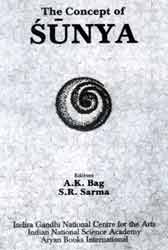|
The history of any country is nothing but a chronicle of its culture and civilization. Culture mainly comprises human thoughts and civilization concerns itself with human thoughts and civilization concerns itself with human action. Two inventions are said to be the turning point in the History of Mankind – fire and wheel and we are very well aware of the changes these inventions brought about.
| The symbolic similarity of the wheel and the zero should not surprise us. Zero did to human thought what the wheel did to human action. Acceleration. And soon from a simple thought the zero blossomed into a multifarious concept. No discipline remained untouched by some or the other shade of zero and that is why zero encompasses all sciences, arts, philosophy and almost, all the disciplines. The present volume Concept of Sunya is an outcome of a seminar jointly held by the IGNCA and (Indian National Science Academy) in February 1997 to celebrate the concept of ‘sunya’ (zero).
The volume contains 24 excellent academic papers of 23 scholars of different disciplines, whose thought process was stirred by the multiple connotations of Sunya. The volume is divided into three broad categories – 1) Sunya in Speculative Thought 2) Sunya in Mathematical System and 3) Ramification of Sunya in other fields. All the three categories are briefly discussed here, sequentially.
|
1) Sunya in Speculative Thought : This section contains eight papers. Swami Jitatmananda has explored the meaning of sunyata in philosophy and science. R.C. Gupta discusses the ‘Technology of using sunya in India;’ K.V. Sarma sheds light on ‘word and Alphabetic numerical system in India;’ B.N. Mukherjee reflects upon ‘Kharoshti Numerals and the Early use of Decimal Notation in Indian Epigraphy’ and S.R. Sarma discusses Sunya in Pingala’s Chandahsutra.
2) Sunya in Mathematical System : This section comprises nine papers. David Pingree discusses ‘Zero and the symbol for zero in Early Sexagesimal and Decimal Place – Value Systems.’ Wang Yusheng throws light on Chinese ‘Ling’ and Indian sunya spread to China. R.C. Gupta expalins the ‘Zero in the Mathematical System of India.’ A.K. Bag explores the ‘Need for zero in the Numerical System of India.’ M.R. Adhikari discusses the ‘Concept of sunya and its ramifications in Mathematics and Computer Science.’
3) Ramification of Sunya in other Fields: This section has seven articles. H.N. Chakravarti writes about the ‘Concept of sunya in Tantra and Agama’; M.C. Joshi explains the ‘Concept of Sunya in Sakta Tantras’; Devangana Desai Discusses ‘Sunya in Context of Temple Art; Prem Lata Sharma describes ‘Sunya in Indian Tala System’; P. Manansala writes about ‘Number Mysticisms in other regions and the impact of Sunya;’ S.C. Malik states the ‘Now – Dimenssionless (no-mind-Sunya) state and R. Sathyanarayana presents ‘Sunya: A Holistic View’.
These papers are preceeded by a short but intense Introduction by the editors which provides the necessary background for understanding the development of the concept as well as the basis of the classification of the papers.
All the papers are well supplemented with copious references. The papers of K.V. Sarma, B.N. Mukherjee, A.K. Bag, S.R. Sarma and R. Sathyanarayana are also fortified with extensive tables and figures.
‘The Concept of Sunya’ is a volume which is a ‘must have’ for anyone interested in knowing the very basic yet so fundamental a concept i.e. the zero; an embodiment of poorna (full); lopa (absence); aakasa(universe); bindu (dot); sunya (circle) and so much more.
A couple of excerpts from the book:
Sunyata: Its Meaning in Philosophy and Science – Swami Jitatmananda: “Om, the infinite fullness is that Brahman. The same infinite fullness in this Brahman. The same infinite fullness springs from (is hidden) in this finite universe. When this same infinite fullness is taken away from the infinite fullness, still what remains is infinite fullness.
The Vedic seers realized the Ultimate Reality or Brahman as Infinite knowledge, Existence and bliss. Brahman is real (brahma satyam), Sankaracharya, the greatest champion of Advaita Vedanta asserted. Only, he continued, in order to attain that realization one must realize this transient phenomenal universe as a void, a total emptiness – jagat mithya.
After realization, this empty, transient evanescent world of space-time appears, as a manifestation of that One Reality Brahman (jivo brahma eva na aparah). Nature abhors vacuum. Voidness is always filled with fullness.”
Sunya in the Context of Temple Art – Devangana Desai: “Similarly, the nucleus of the garbhagrha (sanctum) in the temple is the zero-point, the potential All-point. It is the metaphysical and physical centre of the temple. The garbhagrha is a crucial area of the temple. It is a hollow chamber which is like a cave, guha. In enshrines an emblem or the image of divinity. Expansion proceeds from the central point of thegarbhagrha in horizontal and all directions of space.
It is a single principle from which everything issues and to which everything is connected. The final, the highest point of the sikhara (superstructure), lies exactly above the centre of the garbhagrh. This high point, the final is also conceived of as the visual equivalent of bindu. The points -the centre of the Brahmasthan on the ground level and the finial in the aakasa (space, sky) – are connected by a vertical axis. As Stella Kramrisch says, it is an invisible axis which traverses the sanctum like a hollow reed (sunysa Madhya). It is the Cosmic Axis which connects the heaved and earth”.
Book reviewed by Dr. Sudhir Kr. Lall
SRO, Kalakosa, IGNCA
The Concept of Sunya
Edited by A.K. Bag and S.R. Sarma
Publisher: IGNCA, INSA & Aryan book International
ISBN: 81-7305-240-9; 287 pp.figs, tables; Rs. 1250/-
|

